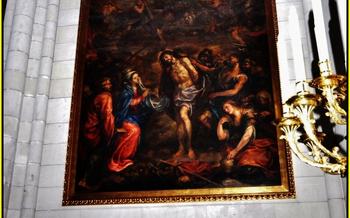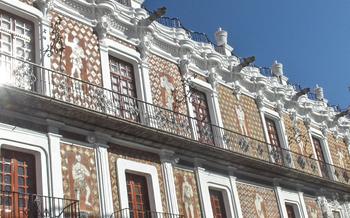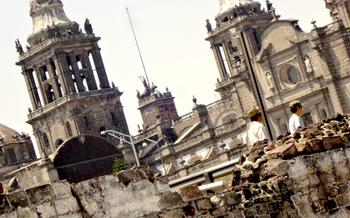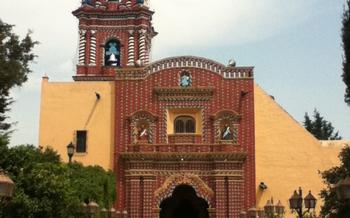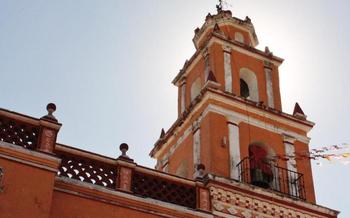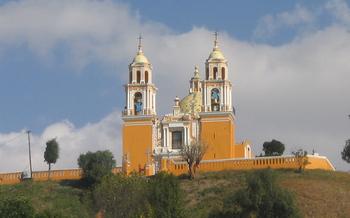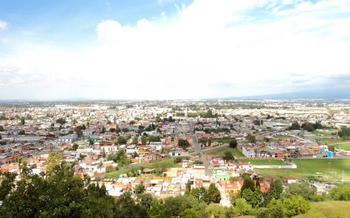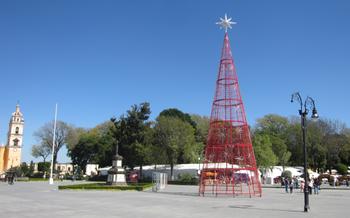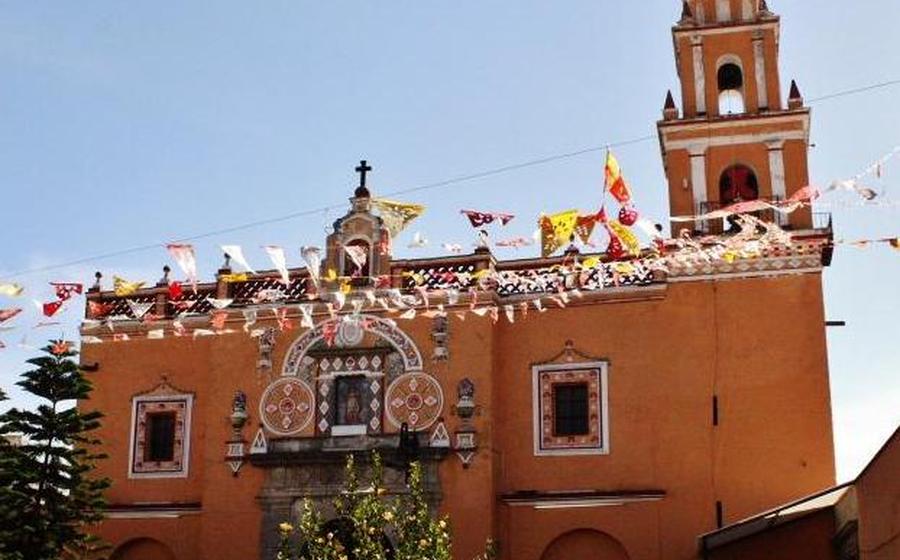
Parroquia de Santiago Xicotenco
- The Parroquia de Santiago Xicotenco: A Historical Overview
- Visiting the Parroquia de Santiago Xicotenco: Practical Information
- Exploring the Interior of the Parroquia de Santiago Xicotenco
- The Tower of the Parroquia de Santiago Xicotenco: A Unique Perspective
- The Atrium of the Parroquia de Santiago Xicotenco: A Place of Gathering
- The Surrounding Neighborhood of Xicotenco: A Cultural Experience
- The Parroquia de Santiago Xicotenco as a Symbol of Faith and is more than just a historical landmark; it serves as a spiritual beacon and a gathering place for social and cultural events. The church plays a central role in the religious life of the community, hosting regular masses, special celebrations, and pilgrimages. During these events, the church becomes a focal point of unity and devotion, bringing people from all walks of life together to share in their faith.
- Restoration and Preservation Efforts at the Parroquia de Santiago Xicotenco
- The Parroquia de Santiago Xicotenco in the Context of Mexican Baroque Architecture
- The Parroquia de Santiago Xicotenco as a UNESCO World Heritage Siteotenco has been recognized as a UNESCO World Heritage Site, a designation bestowed upon landmarks of outstanding universal significance. The church meets several criteria for this prestigious designation, including:
- Tips for Making the Most of Your Visit to the Parroquia de Santiago Xicotenco
- The Parroquia de Santiago Xicotenco in Literature and Art
- The Parroquia de Santiago Xicotenco in the Digital Age
- Insider Tip: Hidden Gems of the Parroquia de Santiago Xicotenco
The Parroquia de Santiago Xicotenco: A Historical Overview
The Parroquia de Santiago Xicotenco, situated in the heart of Cholula, Mexico, holds a rich history that dates back to the 16th century. Constructed during the early colonial period, this magnificent church stands as a testament to the blending of indigenous and European architectural styles. Initially, a small chapel dedicated to Santiago Apóstol was built on this site in 152However, as the population of Cholula grew, the chapel was expanded into a larger church over the following centuries. The church's current structure, showcasing a mix of Renaissance, Baroque, and indigenous elements, was completed in the 18th century. Throughout its history, the Parroquia de Santiago Xicotenco has served as a spiritual and cultural hub for the local community, playing a vital role in their religious practices and traditions.
Visiting the Parroquia de Santiago Xicotenco: Practical Information
Location and accessibility: The Parroquia de Santiago Xicotenco is situated in the heart of Cholula, a city renowned for its cultural and historical significance. Reaching the church is a breeze, as it lies within easy walking distance from the city center. Its central location makes it a convenient stop for visitors exploring Cholula's other attractions.
Hours of operation: The church welcomes visitors during specific hours to ensure a peaceful and respectful environment. Its doors are typically open from 9:00 AM to 1:00 PM, and then again from 4:00 PM to 7:00 PM, allowing ample time for exploration and prayer.
Admission fees and guided tours: Admission to the Parroquia de Santiago Xicotenco is free of charge, allowing everyone to experience its grandeur without financial barriers. Visitors are encouraged to make donations to support the church's maintenance and preservation efforts. Guided tours are available upon request, providing an opportunity to delve deeper into the church's history, architecture, and significance.
Exploring the Interior of the Parroquia de Santiago Xicotenco
Adorned with intricate details and vibrant colors, the interior of the Parroquia de Santiago Xicotenco is a testament to the artistry and devotion of its creators. As you step inside, your gaze is immediately drawn to the main altar, a masterpiece of Baroque splendor. Its intricate carvings, gilded accents, and vibrant paintings depict scenes from the life of Saint James the Apostle, the church's patron saint.
The side chapels, each dedicated to a different saint, offer their own unique charm. The Chapel of the Virgin Mary features a beautiful statue of the Virgin of Guadalupe, surrounded by delicate murals depicting her apparitions. The Chapel of the Holy Sacrament houses a stunning altarpiece showcasing the Eucharist, while the Chapel of Saint Joseph displays intricate carvings depicting the life of Jesus' earthly father.
Don't miss the opportunity to admire the intricate artwork adorning the walls and ceilings of the church. From the vibrant frescoes depicting biblical scenes to the delicate azulejos tiles adding a touch of Portuguese influence, every corner of the interior reveals a new artistic treasure.
The Tower of the Parroquia de Santiago Xicotenco: A Unique Perspective
The Parroquia de Santiago Xicotenco boasts a majestic tower that stands as a symbol of its architectural grandeur and religious significance. Constructed in the 18th century, the tower is a testament to the ingenuity and craftsmanship of the builders who created it. Its intricate carvings and decorative elements showcase the fusion of indigenous and European influences that characterized Mexican Baroque architecture.
History and Significance of the Tower
The tower of the Parroquia de Santiago Xicotenco holds a deep historical and religious significance for the local community. It was originally conceived as a watchtower, serving as a vantage point for spotting approaching enemies or fires. However, over time, it evolved into a symbol of faith and devotion, becoming an integral part of the church's identity. The tower's height and prominence made it a landmark, visible from miles away, guiding pilgrims and travelers to the sacred site.
Climbing the Tower for Panoramic Views
For those seeking breathtaking views of Cholula and the surrounding region, climbing the tower of the Parroquia de Santiago Xicotenco is a must. The arduous ascent through narrow spiral staircases is rewarded with panoramic vistas that stretch across the city's rooftops, the lush countryside, and the distant mountains. On clear days, visitors can even catch a glimpse of the majestic Popocatépetl volcano, its snow-capped peak piercing the azure sky.
The Bells and Their Role in the Community
The tower of the Parroquia de Santiago Xicotenco is home to a set of bells that have played a vital role in the daily life of the community for centuries. Cast from bronze and adorned with intricate designs, these bells serve as a melodious reminder of the church's presence. Their ringing marks the hours, summons the faithful to prayer, and announces special occasions and festivals. The bells have become an integral part of the town's soundscape, a familiar melody that echoes through the cobblestone streets, connecting generations and fostering a sense of unity among the residents.
The Atrium of the Parroquia de Santiago Xicotenco: A Place of Gathering
The atrium of the Parroquia de Santiago Xicotenco is a spacious and inviting open space that serves as a gathering place for the local community. Designed in accordance with the canons of Mexican Baroque, it is enclosed by a low wall, forming a rectangle that extends from the church's main entrance to the street.
The central feature of the atrium is a beautiful fountain, which symbolizes the gift of life and purity. Intricate carvings adorn the fountain's base, depicting cherubs and other mythical creatures. The fountain is a popular spot for visitors to relax and take in the beauty of the surroundings.
Throughout the year, the atrium hosts various cultural events and celebrations. During religious festivals, the space is transformed into a lively marketplace, where vendors sell traditional handicrafts, food, and souvenirs. The atrium also serves as a venue for concerts, dance performances, and other cultural events, showcasing the vibrant traditions of Cholula.
During the annual feast of Santiago Xicotenco, the atrium bursts into life with music, dance, and colorful decorations. Locals and visitors alike gather to celebrate the patron saint of the church, participating in processions, traditional dances, and other festivities. The atrium becomes a vibrant hub of activity, reflecting the deep connection between the church and the community.
The Surrounding Neighborhood of Xicotenco: A Cultural Experience
The neighborhood surrounding the Parroquia de Santiago Xicotenco is a vibrant and culturally rich area that offers visitors a glimpse into the traditional Mexican way of life. Here, one can find bustling markets where locals buy and sell fresh produce, handicrafts, and delicious street food. The aromas of traditional Mexican cuisine, such as tacos, tamales, and mole poblano, fill the air, inviting visitors to sample the local flavors.
Amidst the lively markets, visitors can discover hidden gems such as small handicraft shops where skilled artisans create beautiful pottery, textiles, and jewelry. These shops are a treasure trove of unique souvenirs that showcase the region's rich cultural heritage. Throughout the year, the neighborhood comes alive with festivals and events that celebrate local traditions and customs. These celebrations often feature music, dance, traditional food, and colorful parades, providing visitors with an unforgettable cultural experience.
The Parroquia de Santiago Xicotenco as a Symbol of Faith and is more than just a historical landmark; it serves as a spiritual beacon and a gathering place for social and cultural events. The church plays a central role in the religious life of the community, hosting regular masses, special celebrations, and pilgrimages. During these events, the church becomes a focal point of unity and devotion, bringing people from all walks of life together to share in their faith.
Beyond its religious significance, the Parroquia de Santiago Xicotenco has also become an important social and cultural hub for the community. The atrium of the church serves as a meeting point, where locals gather to socialize, exchange news, and participate in various community activities. It is a place where people come together to celebrate festivals, organize events, and connect with one another, strengthening the bonds of community and fostering a sense of belonging.
Restoration and Preservation Efforts at the Parroquia de Santiago Xicotenco
The Parroquia de Santiago Xicotenco has undergone several restoration and preservation projects over the years to maintain its architectural integrity and historical significance. Recognizing the importance of preserving this cultural heritage, local authorities, organizations, and the community have collaborated to protect and restore the church's original features.
One of the most notable restoration projects was undertaken in the early 2000s, focusing on the repair and reinforcement of the church's structure. This involved addressing cracks and damage to the walls, stabilizing the tower, and restoring the intricate decorative elements on the façade. Skilled artisans and craftsmen were employed to ensure that the repairs adhered to traditional techniques and preserved the church's original character.
In addition, ongoing efforts are made to maintain the church's interior, including regular cleaning, upkeep, and restoration of artwork. The community plays a vital role in supporting these initiatives through donations and volunteer work. By preserving the Parroquia de Santiago Xicotenco, future generations can continue to appreciate its beauty, historical significance, and role as a symbol of faith and community.
The Parroquia de Santiago Xicotenco in the Context of Mexican Baroque Architecture
The Parroquia de Santiago Xicotenco stands as a testament to the unique blend of indigenous and European influences that characterize Mexican Baroque architecture. This distinctive style emerged during the 17th and 18th centuries, reflecting the cultural and artistic exchange between Spain and its colonies in the Americas.
Characteristics of Mexican Baroque Architecture
Mexican Baroque architecture is known for its exuberant ornamentation, intricate facades, and dramatic use of light and shadow. Common features include Churrigueresque-style altarpieces, elaborately carved portals, and decorative tilework. The use of local materials, such as volcanic stone and tezontle, adds a distinctive character to Mexican Baroque buildings.
The Influence of Indigenous and European Styles
The fusion of indigenous and European elements is a defining characteristic of Mexican Baroque. Indigenous influences are evident in the use of pre-Columbian motifs and symbols, such as the feathered serpent Quetzalcoatl. European influences, particularly from Spain and Italy, can be seen in the adoption of Renaissance and Mannerist architectural forms and decorative elements.
The Unique Features of the Parroquia de Santiago Xicotenco
The Parroquia de Santiago Xicotenco exemplifies the fusion of indigenous and European influences in Mexican Baroque architecture. Its facade features a mix of Churrigueresque and indigenous motifs, including carved representations of local flora and fauna. The interior of the church is adorned with intricate frescos and sculptures that depict biblical scenes and saints, blending European iconography with indigenous artistic traditions.
The Parroquia de Santiago Xicotenco is a remarkable example of Mexican Baroque architecture, showcasing the unique blend of indigenous and European influences that define this distinctive style.
The Parroquia de Santiago Xicotenco as a UNESCO World Heritage Siteotenco has been recognized as a UNESCO World Heritage Site, a designation bestowed upon landmarks of outstanding universal significance. The church meets several criteria for this prestigious designation, including:
-
Authenticity: The church has retained its original form and structure, with minimal alterations or modifications over the centuries. Its architectural integrity and authenticity showcase the craftsmanship and artistic vision of its original builders.
-
Representativeness: The Parroquia de Santiago Xicotenco is an outstanding example of Mexican Baroque architecture, a unique blend of indigenous and European influences. It embodies the cultural and artistic exchange that shaped Mexico's colonial heritage.
-
Rarity: The church's distinctive design, featuring its intricate facade and towering steeple, sets it apart from other Baroque churches in the region. Its unique characteristics make it a rare and exceptional example of this architectural style.
-
Integrity: The church has been well-maintained and preserved, ensuring its physical integrity and retaining its original character. Restoration efforts have been carried out with great care and respect, preserving the church's historical and artistic significance.
The UNESCO World Heritage status recognizes the exceptional value of the Parroquia de Santiago Xicotenco, not only for Mexico but for the world. It highlights the importance of preserving and celebrating cultural heritage, ensuring that future generations can appreciate and learn from this architectural masterpiece.
Tips for Making the Most of Your Visit to the Parroquia de Santiago Xicotenco
To fully appreciate the beauty and significance of the Parroquia de Santiago Xicotenco, consider the following tips for a memorable visit:
-
Timing your visit: For a tranquil experience, avoid peak tourist hours, which typically fall on weekends and during religious holidays. Instead, opt for a weekday morning or late afternoon when the church is less crowded.
-
Dress appropriately: Respect the sacred nature of the church by dressing modestly. Avoid shorts, tank tops, and revealing clothing.
-
Mind your manners: Be mindful of your behavior inside the church. Speak softly, avoid distracting others, and refrain from using flash photography.
-
Explore the surroundings: Take advantage of your visit to explore the charming neighborhood of Xicotenco. Stroll through the traditional markets, savor the local cuisine, and browse the handicraft shops for unique souvenirs.
-
Combine with other attractions: Enhance your experience by combining your visit to the Parroquia de Santiago Xicotenco with other nearby attractions. The Great Pyramid of Cholula, the Church of Santa Maria Tonantzintla, and the Museo de la Ciudad de Cholula are all within easy reach.
The Parroquia de Santiago Xicotenco in Literature and Art
The Parroquia de Santiago Xicotenco has been immortalized in various forms of literature and art. Local poets and writers have drawn inspiration from its history and grandeur, weaving it into their works. The church's unique architectural features and intricate details have been captured in paintings, drawings, and sketches by both local and international artists. These artistic representations not only showcase the church's beauty but also serve as a testament to its cultural significance.
The Parroquia de Santiago Xicotenco has also served as a muse for contemporary artists. Sculptors have created intricate carvings and reliefs depicting scenes from the church's history, while muralists have adorned its walls with vibrant artworks that blend traditional and modern styles. These artistic interventions have transformed the church into a living canvas, allowing visitors to experience its beauty in new and unexpected ways.
The church's cultural significance extends beyond its physical structure. It has become a gathering place for artists, musicians, and performers who draw inspiration from its sacred space. Concerts, plays, and dance performances are often held within the church's walls, creating a harmonious blend of spirituality and creativity.
The Parroquia de Santiago Xicotenco in the Digital Age
The Parroquia de Santiago Xicotenco has embraced the digital age, leveraging technology to connect with a global audience and share its rich history, cultural significance, and architectural beauty. Virtual tours offer an immersive experience for those unable to visit the church in person, allowing them to explore its interiors, admire its artwork, and learn about its history from the comfort of their own homes. These virtual tours are meticulously crafted to provide detailed panoramas, high-resolution images, and engaging narratives, creating a sense of presence and immediacy.
On social media platforms, the Parroquia de Santiago Xicotenco actively engages with followers, sharing stunning photographs, historical anecdotes, and upcoming events. These platforms serve as a vibrant community where visitors can connect, exchange experiences, and seek insider tips. The church's social media presence also extends to live streaming of special events, such as masses, concerts, and festivals, enabling a global audience to participate in these celebrations virtually.
Insider Tip: Hidden Gems of the Parroquia de Santiago Xicotenco
For those willing to explore beyond the obvious, the Parroquia de Santiago Xicotenco holds several hidden gems waiting to be discovered. One such treasure is a secret passage leading to a hidden chamber beneath the altar, said to have been used by priests to store valuable artifacts during times of unrest. Another intriguing feature is the intricate carvings on the underside of the choir loft, often overlooked by visitors but showcasing remarkable craftsmanship. Additionally, the church's exterior boasts hidden niches and sculptures that reveal unique perspectives and storytelling elements. Discovering these hidden gems adds an extra layer of intrigue and fascination to your visit, offering a glimpse into the church's rich history and symbolism.


